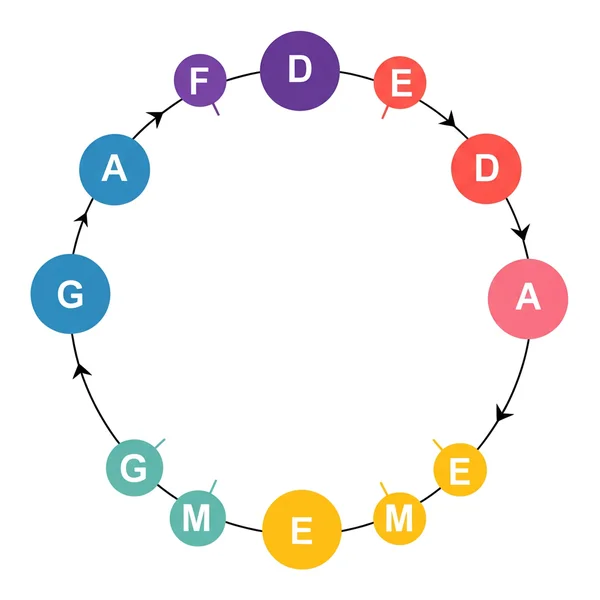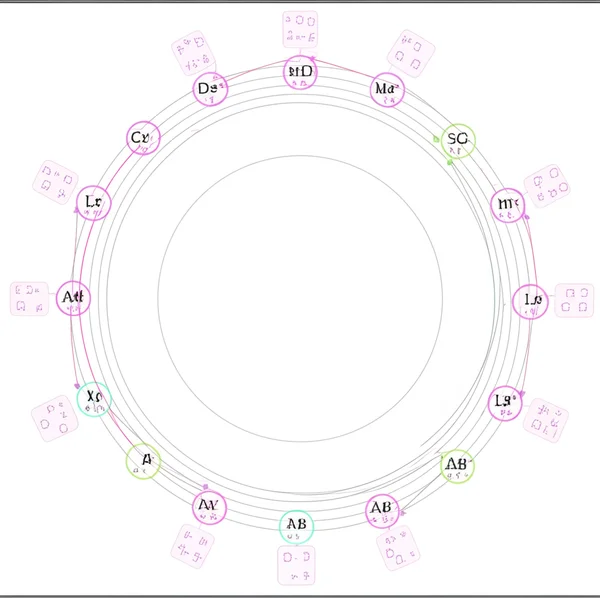Modes & Circle of Fifths: Advanced Theory Guide
Ready to venture beyond major and minor scales and unlock a richer palette of melodic colors? If you're familiar with the Circle of Fifths, you're already holding a key to deeper musical understanding. But how are music modes related to the Circle of Fifths? This guide dives into advanced music theory, exploring the fascinating connection between musical modes and the trusty Circle of Fifths, including the concept of the dorian order circle of fifths. Prepare to expand your compositional toolkit and understanding. For a hands-on exploration of these concepts, visit our interactive tool.
What Are Musical Modes, Anyway?
Before we connect them to the Circle of Fifths, let's briefly ensure we're on the same page about music modes explained. In simple terms, modes are like different "flavors" of a scale. While major (Ionian) and natural minor (Aeolian) scales are the most common, there are seven primary "church modes" or "Greek modes," each with a unique character and intervallic structure:
- Ionian (major scale)
- Dorian
- Phrygian
- Lydian
- Mixolydian
- Aeolian (natural minor scale)
- Locrian Understanding musical modes is about recognizing these distinct sonic personalities.
The Characteristic Notes of Each Mode
Each mode is essentially a major scale starting on a different degree, but it's the unique intervals relative to its own root that give it its color. For instance, Dorian's raised 6th degree is a key characteristic. Lydian's raised 4th gives it a bright, dreamy sound.
Why Modes Matter for Composers and Improvisers
Modes offer a way to break free from standard major/minor tonality, adding depth, emotion, and variety to your music. They are fundamental to many genres, from jazz and folk to film scores and rock. Learning how to use circle of fifths modes can be a game-changer.
Connecting the Circle of Fifths and Musical Modes
So, can the Circle of Fifths help explain musical modes? Yes, significantly! While the Circle itself primarily displays key signatures for major and minor keys, its structure can be used to visualize and organize modes.

Visualizing Modes with Key Signatures (via the Circle)
One common way to understand modes is by relating them to a parent major scale. For example, D Dorian has the same notes as C major (no sharps or flats). The Circle of Fifths tells you the key signature of C major. From there, you just start and end on D to get D Dorian. This applies to all modes and key signatures. You can use our interactive circle of fifths to quickly find the parent major key signature.
The Concept of "Brightness" and "Darkness" in Modes
Modes can be arranged by their perceived "brightness" (more major-like intervals, especially a major third) to "darkness" (more minor-like intervals, especially a minor third). Lydian is often considered the brightest, and Locrian the darkest. This spectrum can also be loosely related to movements around the Circle of Fifths, as adding sharps (moving clockwise) tends to brighten keys/modes, while adding flats (moving counter-clockwise) tends to darken them. This is an advanced circle of fifths applications insight.
The Dorian Order Circle of Fifths Explained
A particularly interesting concept is the dorian order circle of fifths. What is the Dorian order on the Circle of Fifths? This refers to arranging the Dorian modes themselves in a circle of fifths progression.
How the Dorian Mode Relates to the Circle
If you take a Dorian scale (e.g., D Dorian: D E F G A B C) and build a Dorian scale starting a perfect fifth above its root (A Dorian: A B C D E F# G), you'll notice the "key signature" effectively shifts as if moving along the Circle of Fifths (from C major's signature to G major's signature).

Constructing the Dorian Order
You can list Dorian modes whose roots are a fifth apart:
- C Dorian (key signature of Bb major - 2 flats)
- G Dorian (key signature of F major - 1 flat)
- D Dorian (key signature of C major - 0 sharps/flats)
- A Dorian (key signature of G major - 1 sharp)
- E Dorian (key signature of D major - 2 sharps)
- And so on. This sequence follows the same root movement as the Circle of Fifths. This is a core part of advanced music theory that connects modes directly to the Circle's logic. Explore these relationships on our site.
Practical Uses for Composers
Understanding the dorian order circle of fifths can be a powerful tool for music theory for composers. It provides a logical way to modulate between different Dorian modes or to create chord progressions that move smoothly through various modal colors while maintaining a sense of harmonic direction related to the Circle.
Exploring Other Modes with the Circle of Fifths
While the Dorian order is a specific example, the Circle of Fifths can aid in understanding musical modes more broadly. How can I visualize modes using the Circle of Fifths?
Lydian and Mixolydian via the Circle
-
Lydian: Often seen as the "brightest" mode. F Lydian has the notes of C major but sounds distinct. Its "parent" major is a perfect fifth below its root.
-
Mixolydian: The "dominant" sound. G Mixolydian has the notes of C major. Its "parent" major is a perfect fourth below its root (or a fifth above, in the other direction on the circle). The Circle helps identify the parent major scales and thus the necessary accidentals for any mode.

Aeolian, Phrygian, and Locrian Connections
These "darker" modes can also be mapped. For example, A Aeolian (natural minor) is the relative minor of C major, clearly shown on any interactive circle of fifths. Phrygian and Locrian also have their parent major scales discoverable through similar logic relative to the Circle. This scale theory becomes more intuitive with visualization.
Beyond Theory: Applying Modes and the Circle
How do I use modes in music composition? The real magic happens when you move beyond intellectual understanding and start applying these concepts. Use the Circle of Fifths not just as a static chart, but as a dynamic tool for exploring modal harmony and adding unique melodic color to your music.
Experiment by:
- Writing melodies using different modes over static chords.
- Creating chord progressions that emphasize a mode's characteristic notes.
- Using the dorian order circle of fifths or similar modal progressions for sections of your songs.
Our online Circle of Fifths tool can be invaluable for visualizing these circle of fifths modes as you experiment.
What are your favorite modes to compose or improvise with? And have you found other interesting connections between modes and the Circle of Fifths? Share your insights in the comments!
Advanced Circle of Fifths & Modes
-
What is the Dorian order on the Circle of Fifths?
The Dorian order refers to arranging Dorian modes whose tonic notes are a perfect fifth apart, mirroring the progression of keys on the Circle of Fifths. For example, D Dorian (like C major key sig.) followed by A Dorian (like G major key sig.). You can explore Dorian and other modes on our site.
-
How are music modes related to the Circle of Fifths?
The Circle of Fifths primarily shows major/minor key signatures. Modes can be related to these by identifying their "parent" major scale. The Circle helps find this parent scale and its signature, thus defining the notes of the mode. The Circle also helps visualize progressions between modes.
-
Can the Circle of Fifths help explain musical modes?
Yes, it provides a familiar framework (key signatures, root movements) to understand how modes are constructed and how they relate to each other, especially when considering their "parent" major scales. An interactive circle of fifths can make these connections clearer.
-
What's an advanced way to use the Circle of Fifths?
Beyond key signatures and basic chords, using it to understand modal interchange, secondary dominants, tritone substitutions, and systematic modal progressions (like the Dorian order) are all advanced applications. It becomes a tool for deeper harmonic analysis and composition.
-
How can I visualize modes using the Circle of Fifths?
You can visualize a mode by first identifying its parent major key on the Circle (e.g., for D Dorian, the parent is C Major). Then, understand that D Dorian uses all the notes of C Major but starts and ends on D. Our online tool can help you select a key and then mentally (or physically on an instrument) play its modes.